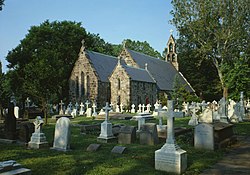Church of St. James the Less
|
St. James-the-Less Episcopal Church
|
|
 |
|
| Location | Hunting Park Ave. at Clearfield St. Philadelphia, Pennsylvania |
|---|---|
| Coordinates | 40°0′14″N 75°10′59″W / 40.00389°N 75.18306°WCoordinates: 40°0′14″N 75°10′59″W / 40.00389°N 75.18306°W |
| Built | 1846 |
| Architect | George Gordon Place; John E. Carver |
| Architectural style | Other, Gothic Revival |
| NRHP Reference # | 74001801 |
| Significant dates | |
| Added to NRHP | November 20, 1974 |
| Designated NHL | February 4, 1985 |
The Church of St. James the Less is a historic Episcopal church in Philadelphia, Pennsylvania, that was architecturally influential. As St. James-the-Less Episcopal Church, it was designated a National Historic Landmark for its Gothic Revival architecture, which influenced a generation of subsequent churches.
Philanthropist and merchant Robert Ralston wanted to found a church near his land on Ridge Road, but died shortly before this church's founding. His friend Samuel Jarvis had helped found the General Theological Seminary in New York and knew about the Cambridge Camden Society. This congregation was admitted to the Episcopal Diocese of Pennsylvania on 22 May 1846 and on 26 September 1846, took the corporate name of "Rector, Church Wardens and Vestrymen of St. James the Less." The new congregation acquired land from nearby Laurel Hill Cemetery and wanted to build a church that could serve not only the wealthy families with mansions overlooking the Schuylkill River or on Hunting Park Avenue, but also working-class people of the nearby industrial neighborhood now known as Allegheny West.
The parish was traditionally High Church. It did not install gas lighting in 1869, but did allow oil lamps to replace the original candles circa 1885. Further modernization occurred in the early 20th century, including not only the tower and chimes (dedicated 1910) but also electric lighting and central heat circa 1913. Documents concerning its Anglo-Catholic practices in the early 20th century.
The building was added to the list of National Register of Historic Places in 1974 and designated a National Historic Landmark in 1985. The National Park Service called it "the first example of the pure English Parish church style in America, and one of the best examples of a 19th-century American Gothic church for its coherence and authenticity of design. Its influence on the major architects of the Gothic Revival in the United States was profound."
...
Wikipedia
